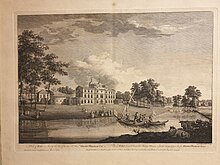
Edward the Martyr was King of the English from 8 July 975 until he was killed in 978. He was the eldest son of King Edgar. On Edgar's death, the succession to the throne was contested between Edward's supporters and those of his younger half-brother, the future King Æthelred the Unready. As they were both children, it is unlikely that they played an active role in the dispute, which was probably between rival family alliances. Edward's principal supporters were Dunstan, Archbishop of Canterbury, and Æthelwine, Ealdorman of East Anglia, while Æthelred was backed by his mother, Queen Ælfthryth and her friend Æthelwold, Bishop of Winchester. The dispute was quickly settled. Edward was chosen as king and Æthelred received the lands traditionally allocated to the king's eldest son in compensation.

Ramsey Abbey was a Benedictine abbey in Ramsey, Huntingdonshire, England. It was founded about AD 969 and dissolved in 1539.

William of Wykeham was Bishop of Winchester and Chancellor of England. He founded New College, Oxford, and New College School in 1379, and founded Winchester College in 1382. He was also the clerk of works when much of Windsor Castle was built.
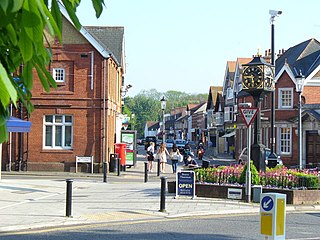
Cobham is a large village in the Borough of Elmbridge in Surrey, England, centred 17 miles (27 km) south-west of London and 10 miles (16 km) northeast of Guildford on the River Mole. It has a commercial/services High Street, a significant number of primary and private schools and the Painshill landscape park.

Esher is a town in the borough of Elmbridge in Surrey, England, to the east of the River Mole.

Earl of Shaftesbury is a title in the Peerage of England. It was created in 1672 for Anthony Ashley-Cooper, 1st Baron Ashley, a prominent politician in the Cabal then dominating the policies of King Charles II. He had already succeeded his father as second Baronet of Rockbourne in 1631 and been created Baron Ashley, of Wimborne St Giles in the County of Dorset, in 1661, and he was made Baron Cooper, of Paulett in the County of Somerset, at the same time he was given the earldom.
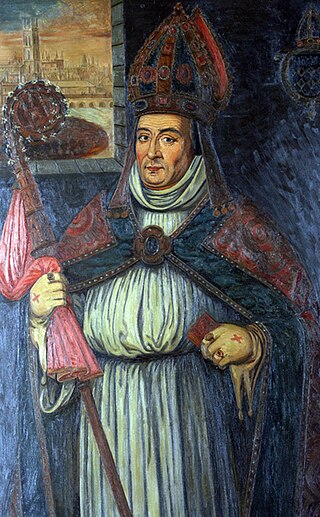
William Waynflete, born William Patten, was Headmaster of Winchester College (1429–1441), Provost of Eton College (1442–1447), Bishop of Winchester (1447–1486) and Lord Chancellor of England (1456–1460). He founded Magdalen College, Oxford, and three subsidiary schools, namely Magdalen College School in Oxford, Magdalen College School, Brackley in Northamptonshire and Wainfleet All Saints in Lincolnshire.
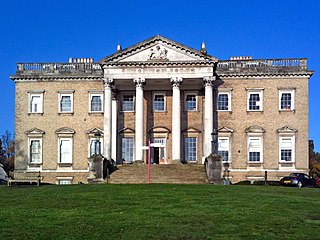
Claremont, also known historically as 'Clermont', is an 18th-century Palladian mansion less than a mile south of the centre of Esher in Surrey, England. The buildings are now occupied by Claremont Fan Court School, and its landscaped gardens are owned and managed by the National Trust. Claremont House is a Grade I listed building.

Edgar Vincent, 1st Viscount D'Abernon, was a British politician, diplomat, art collector and author.

Oxshott is a suburban village in the borough of Elmbridge in Surrey, England. Oxshott includes hilly acidic heath which is partly wooded and occupies the land between the large towns of Esher and Leatherhead. The Oxshott section of the single carriageway north-south A244 runs through its middle and briefly forms its high street, centred two miles from the A3 and the M25.

Tom Tower is a bell tower in Oxford, England, named after its bell, Great Tom. It is over Tom Gate, on St Aldates, the main entrance of Christ Church, Oxford, which leads into Tom Quad. This square tower with an octagonal lantern and facetted ogee dome was designed by Christopher Wren and built 1681–82. The strength of Oxford architectural tradition and Christ Church's connection to its founder, Henry VIII, motivated the decision to complete the gatehouse structure, left unfinished by Cardinal Wolsey at the date of his fall from power in 1529, and which had remained roofless since. Wren made a case for working in a Late Gothic style—that it "ought to be Gothick to agree with the Founders worke"—a style that had not been seen in a prominent building for a hundred and fifty years, making Tom Tower a lonely precursor of the Gothic Revival that got underway in the mid-18th century. Wren never came to supervise the structure as it was being erected by the stonemason he had recommended, Christopher Kempster of Burford.

Old Burghclere is part of Burghclere in Hampshire, England, located south of the large town of Newbury near the A34 road. The village of Burghclere, but less so Old Burghclere, was once on the A34 and has now been by-passed, although this section is not really part of the Newbury bypass.

Richard Drake of Esher, was Equerry of the Stable and Groom of the Privy Chamber to Queen Elizabeth I. He also held office as a Member of Parliament and Justice of the Peace.
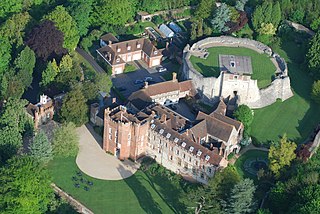
Farnham Castle is a 12th-century castle in Farnham, Surrey, England. It was formerly the residence of the Bishops of Winchester.
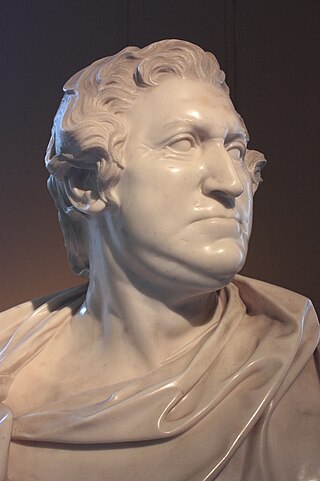
Lt.-Gen. Henry Herbert, 9th Earl of Pembroke, 6th Earl of Montgomery was an English peer and courtier. He was the heir and eldest son of Thomas Herbert, 8th Earl of Pembroke and his first wife Margaret Sawyer. He was styled Lord Herbert from birth until he inherited his father's earldoms of Pembroke and Montgomery in 1733. He also became Lord of the bedchamber to King George II of the House of Hanover.
Edward Lapidge (1779–1860) was an English architect, who held the post of county surveyor of Surrey and designed Kingston Bridge.

Wayneflete Tower, also known as Waynflete's Tower, is an historical gatehouse located in Esher, near London. Part of the Palace of Esher established in 1462 by Bishop William Waynflete of Winchester, it was connected to the keep by a curtain wall. Demolition in the 17th century removed furnishings and granite blocks. In the 18th century, the tower was made part of a Gothic mansion house by William Kent for new owner Henry Pelham. The tower is a Grade I listed building.

Lower Green is a residential and commercial area within Esher, in Surrey, England, on the banks of the River Ember and River Mole. The area has many businesses, most of them in the commercial complex comprising Sandown Industrial Complex and Royal Mills.
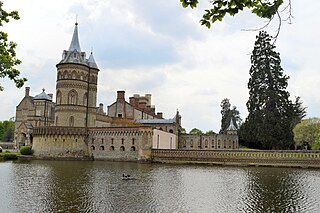
Horsley Towers, East Horsley, Surrey, England is a country house dating from the 19th century. The house was designed by Charles Barry for the banker William Currie. The East Horsley estate was later sold to William King-Noel, 1st Earl of Lovelace who undertook two major expansions of the house to his own designs. Lovelace lived at the Towers with his wife, Ada, daughter of Lord Byron, a pioneering mathematician, friend of Charles Babbage and described as among the first computer programmers. In 1919, the Towers was purchased by Thomas Sopwith, the aviator and businessman, who named his plane, the Hawker Horsley, after his home. Now a hotel, wedding and conference venue set in parkland with a total area of about 50 acres, Horsley Towers is a Grade II* listed building.



